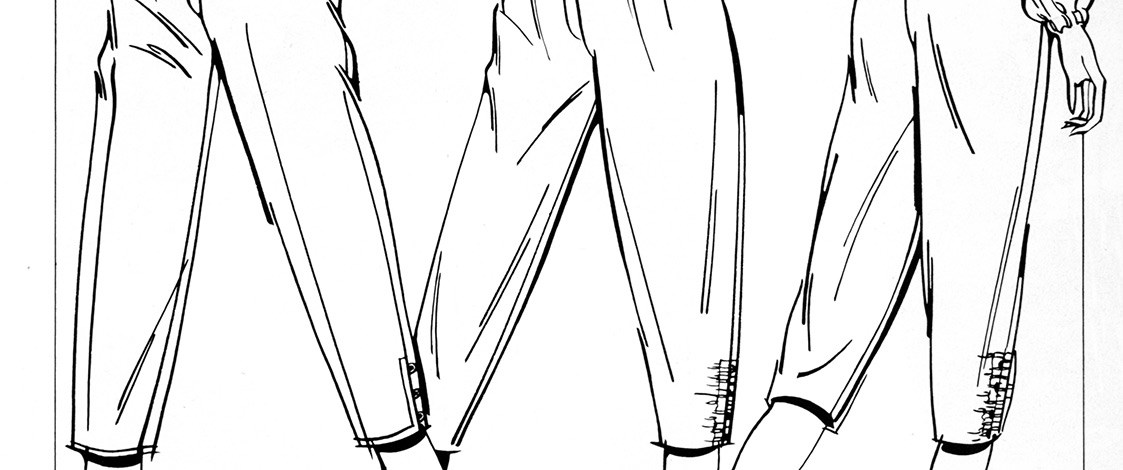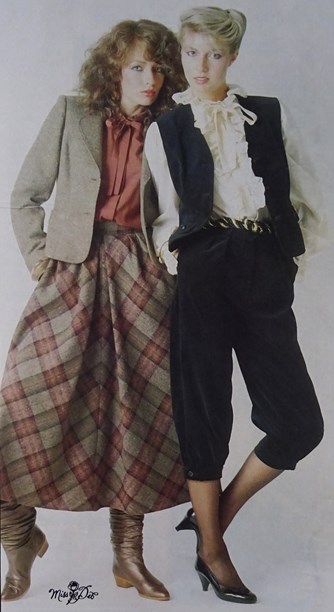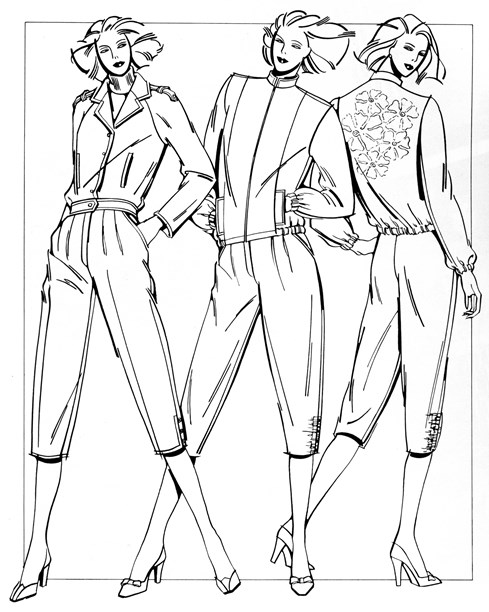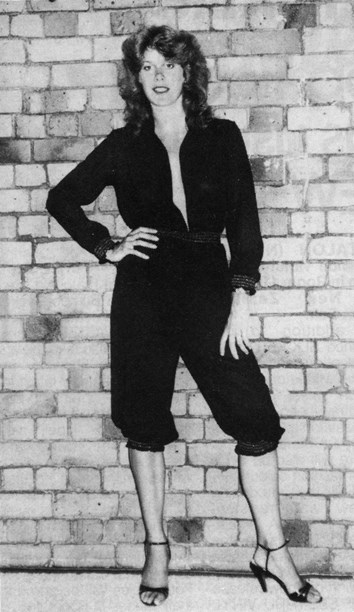Stories
Knickerbockers
1982

In winter 1982, the knickerbocker was the single most important look of the season. Bruce Wells of Ward Wells, one of the many New Zealand fashion manufacturers to embrace the trend, may have been overstating the case when he told trade magazine Apparel that "skirts for winter are dead" but he wasn’t exaggerating the popularity of the half-mast pants.
Variations of the knickerbocker, in a wide array of fabrics and colours, turned up in the winter ranges of Peppertree, Pumperdink, Love Story, Macjays, Society Fashions and Miss Deb.

Miss Deb knickerbockers (right) are modelled by Delys Nottle and teamed with a matching vest and ruffled shirt.
Marnie paired their knickerbockers with matching bomber jackets and Silk Degrees ventured into the glamour zone with fancy designs for after-five.

Knickerbockers with matching bomber jackets from the Marnie range by Marnella Fashions, winter 1982. Image © Marnella Fashions.
All-in-ones with knickerbocker legs provided an alternative to the traditional knickerbocker, and new names were conjured up to describe them. Ward Wells’ all-in-ones went by the name 'jump-knicks' while Wellfit’s were known as 'knickerdresses'.

Knickerbocker all-in-ones by Ward Wells, winter 1982. Image © Ward Wells.
Entrants in the 1982 Benson & Hedges Fashion Design Awards, held that March at Trillos in Auckland, were equally in thrall to the baggy britches. "If I was asked to name one fashion that has really made an impact this year, I would have to say knickerbockers", said the event’s organiser Maysie Bestall-Cohen.
Interpreted in jersey, crepe, cotton, silk, suede, wool, velvet, even gold lurex, knickerbockers featured across the board in the Sportswear, Casual Daywear, High Fashion Daywear, Young Designer of the Year and After-Five High Fashion categories. Nominees included Jane Daniels for Sherwood Fashions (wool velour knickerbockers and topcoat with an Italian mohair waistcoat and wool challis shirt), Miss Deb (moss green velvet knickerbockers and blouson jacket), Peppertree (black wool knickerbockers and bell-hop jacket), Skin Things (three-piece knickerbocker suit in New Zealand glove suede), Helene Barber (hand-dyed silk knickerbockers and reversible padded vest). In the Manufacturers section, a midnight blue velvet knickerbocker and cape ensemble by Thornton Hall beat a bevy of gala gowns to win the After-Five High Fashion Award, further enhancing the knickerbocker’s status.

Gold lurex jersey knit knickerbockers (right) by Pumperdink. Miss Deb (left) also picks up on the gold and glitter theme, offering an evening pants alternative.
Looking to cash in on the craze, Bonds Hosiery rushed a line of knickerbocker-specific hose into production. Called Kneehuggers and fashioned from a ribbed knit, they came to just above the knee and were available in several colours including flame, ebony, sand, leaf and rust.
By spring 1982, it was all over. The knickerbocker had done its dash.
Bill Hall of Society Fashions, and possibly others, was left with hundreds of pairs of knickerbockers he couldn’t sell. Robyn Hall, Bill’s wife and business partner, can’t recall what became of the redundant stock but she does remember her own knickerbocker experience. On a business trip to Paris, she purchased a designer jacket, a burgundy suede blouson complete with power shoulders and gathered sleeve-heads, specifically to wear with her knickerbockers. "It cost a fortune but when the knickerbocker died I never wore it again."
New Zealand’s obsession with knickerbockers in 1982 is difficult to fathom as the trend had previously surfaced on the international fashion scene in the early 1970s and made little impact here. The New Zealand Fashion Museum collection contains just two examples from this period - knickerbocker overalls by Anne Bonza and a man’s corduroy velvet knickerbocker suit by Auckland designer Colin Cole. The appearance of this suit at that particular time may, however, have been co-incidental rather than trend-driven. The look on which it is based, that of the English country gentleman or squire, is consistent with Colin Cole’s penchant for dressing women, and briefly men, from the upper levels of society. He never made knickerbockers for women.
Text by Cecilie Geary. Banner image © Marnella Fashions.
Last published August 2017.